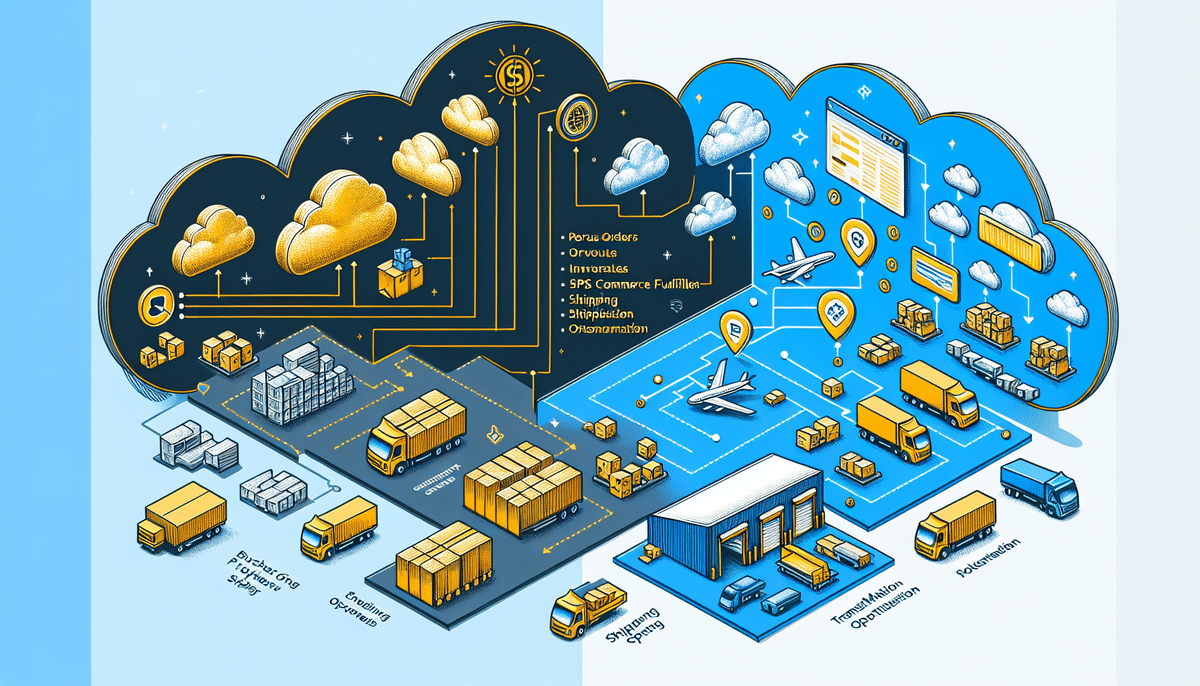SPS Commerce Fulfillment (EDI) vs Blue Yonder WMS: Comprehensive Comparison
Choosing the right warehouse management system (WMS) or electronic data interchange (EDI) solution is crucial for optimizing your supply chain operations. Two prominent options are SPS Commerce Fulfillment (EDI) and Blue Yonder WMS (formerly JDA Software). This comparison will help you determine which solution best fits your business needs.
Overview of SPS Commerce Fulfillment (EDI) and Blue Yonder WMS
Before delving into a detailed comparison, it's essential to understand the core functionalities of each system.
SPS Commerce Fulfillment (EDI)
SPS Commerce Fulfillment (EDI) is a cloud-based EDI solution that facilitates seamless communication between businesses and their trading partners. It enables the exchange of electronic business documents such as purchase orders, invoices, and shipping notices, streamlining order fulfillment processes and reducing manual errors.
Blue Yonder WMS
Blue Yonder WMS is a robust warehouse management system designed to help businesses manage inventory, track shipments, and optimize warehouse operations. It offers features that enhance inventory accuracy, reduce labor costs, and accelerate order fulfillment.
Key Features and Capabilities
Both SPS Commerce Fulfillment (EDI) and Blue Yonder WMS offer a suite of features tailored to enhance supply chain efficiency. Here are the standout features of each:
Features of SPS Commerce Fulfillment (EDI)
- Cloud-based architecture for easy setup and maintenance
- Integration with various ERP, accounting, and e-commerce platforms
- Automation of order and invoice processing
- Real-time tracking and monitoring of order status
- Comprehensive reporting and analytics tools
Features of Blue Yonder WMS
- Real-time inventory visibility across multiple locations
- Automation of warehouse workflows and tasks
- Advanced inventory management tools like cycle counting and ABC analysis
- Support for various shipping methods
- Customization of workflows and rules to fit specific business needs
Integration Capabilities
Seamless integration with existing systems is vital for maximizing the efficiency of your supply chain operations. Here's how each solution fares:
SPS Commerce Fulfillment (EDI) Integration
This system integrates effortlessly with a wide range of business systems, including ERP, accounting, and transportation management systems (TMS). Utilizing APIs, it ensures real-time data exchange, minimizing manual data entry and enhancing data accuracy.
Blue Yonder WMS Integration
Blue Yonder WMS also offers extensive integration capabilities, connecting with ERP, accounting, and labor management systems (LMS). Its use of APIs and connectors facilitates real-time data exchange and workflow automation, optimizing the entire supply chain.
User Experience and Support
The usability and support of a system significantly impact its effectiveness within your organization.
SPS Commerce Fulfillment (EDI) User Experience
SPS Commerce provides a user-friendly interface designed to simplify EDI-related tasks. While it automates many processes, some users may find customization options limited, potentially posing challenges when integrating with specific systems.
Blue Yonder WMS User Experience
Blue Yonder offers a comprehensive and customizable user interface capable of handling high volumes of inventory and transactions. Although powerful, it may present a steeper learning curve for new users, necessitating thorough training and onboarding.
Customer Support
Both solutions prioritize customer support, offering multiple channels such as phone, email, and online portals. Additionally, they provide training resources to help businesses effectively utilize their systems.
Pricing Models
Understanding the pricing structures is essential for budgeting and making an informed decision.
SPS Commerce Fulfillment (EDI) Pricing
SPS Commerce typically charges a setup fee along with a monthly subscription based on transaction volumes. Pricing can range from several hundred to several thousand dollars per month, depending on the scale and specific requirements of your business.
Blue Yonder WMS Pricing
Blue Yonder's pricing is generally based on the number of users and the features selected. Costs can vary from a few thousand to tens of thousands of dollars annually, tailored to the size and complexity of your warehouse operations.
Advantages and Limitations
Each system has its strengths and potential drawbacks, which should be considered in the context of your business needs.
Advantages of SPS Commerce Fulfillment (EDI)
- Automates crucial tasks like order processing and invoicing, enhancing productivity
- Real-time order tracking improves visibility and customer responsiveness
- Reduces manual labor costs associated with data entry
Advantages of Blue Yonder WMS
- Comprehensive inventory management tools optimize stock levels and reduce waste
- Real-time shipment tracking enhances delivery times and customer satisfaction
- Automation of inventory and order fulfillment processes lowers labor costs
Limitations
- SPS Commerce Fulfillment (EDI) may lack extensive customization options for specific business needs.
- Blue Yonder WMS might be more complex for smaller businesses with limited inventory.
- Both systems can have a steep learning curve, requiring significant training and adjustment time.
Implementation Best Practices
Successfully implementing SPS Commerce Fulfillment (EDI) or Blue Yonder WMS requires careful planning and execution. Here are some best practices:
- Define Clear Goals: Establish what you aim to achieve with the system to guide the implementation process.
- Comprehensive Training: Ensure your team is well-trained to maximize the system’s potential.
- Thorough Testing: Conduct extensive testing to identify and resolve any issues before full deployment.
- Continuous Monitoring: Regularly assess system performance to make necessary adjustments and improvements.
Future Developments and Updates
Both SPS Commerce and Blue Yonder are committed to continually enhancing their solutions to meet evolving business needs.
SPS Commerce Fulfillment (EDI) Updates
SPS Commerce recently launched SPS Commerce Automation, an advanced platform offering enhanced automation tools to further streamline supply chain operations.
Blue Yonder WMS Updates
Blue Yonder introduced Blue Yonder Luminate, a predictive analytics platform that provides businesses with data-driven insights for more informed decision-making in supply chain management.
Real-World Success Stories
Examining case studies can provide valuable insights into how these systems perform in real-world scenarios.
- Blue Yonder WMS Case Study: A global apparel retailer improved inventory accuracy by 20% and increased productivity by 10% after implementing Blue Yonder WMS. Read more.
- SPS Commerce Fulfillment (EDI) Case Study: A specialty foods distributor reduced order processing time by 40% and eliminated manual data entry errors using SPS Commerce Fulfillment (EDI). Read more.
Conclusion: Choosing the Right Solution for Your Business
Both SPS Commerce Fulfillment (EDI) and Blue Yonder WMS offer robust solutions tailored to different aspects of supply chain management. Your choice should be guided by factors such as your business type, specific pain points, budget, and support needs. Carefully assess which system aligns best with your operational goals to enhance efficiency and drive growth.






















